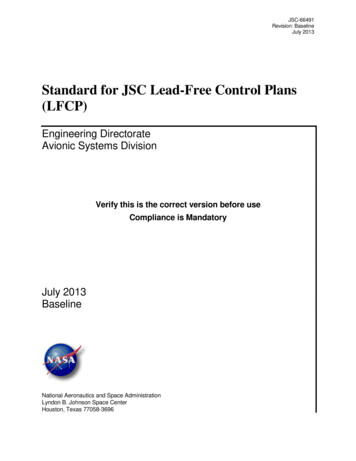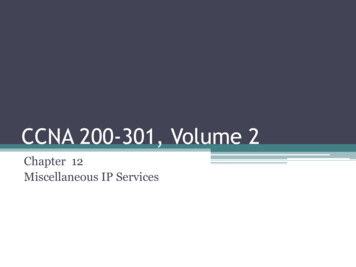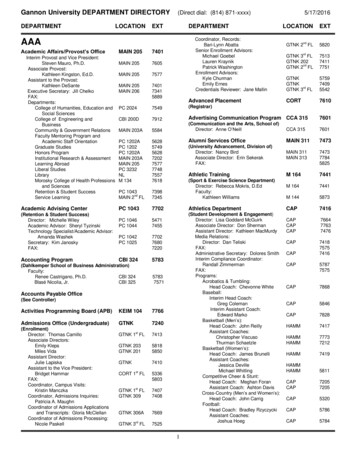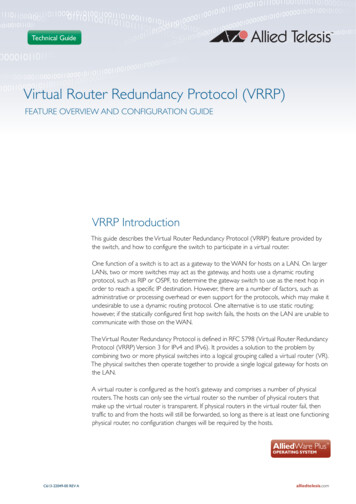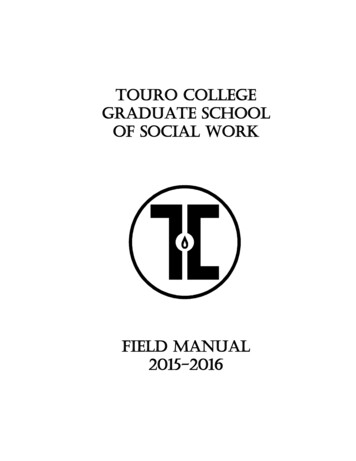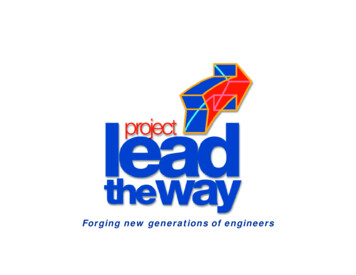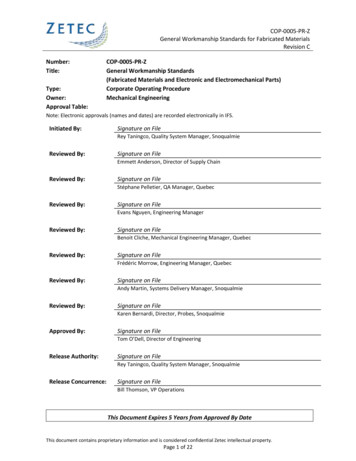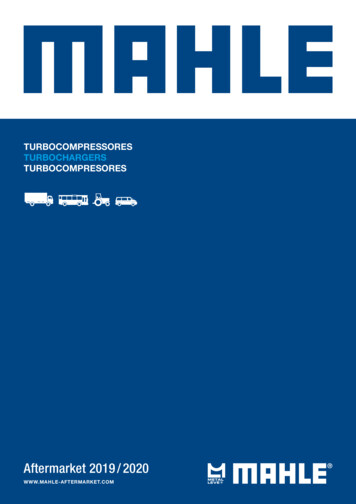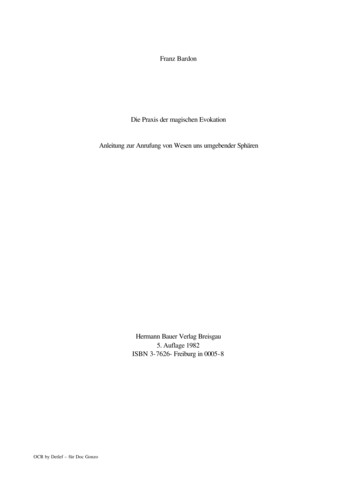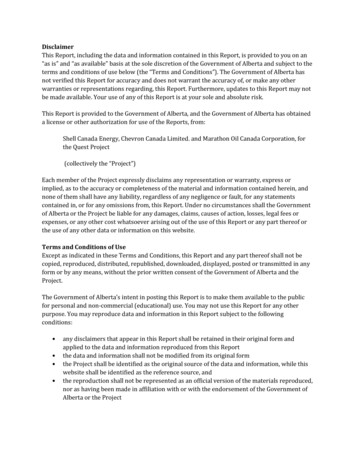
Transcription
DisclaimerThis Report, including the data and information contained in this Report, is provided to you on an“as is” and “as available” basis at the sole discretion of the Government of Alberta and subject to theterms and conditions of use below (the “Terms and Conditions”). The Government of Alberta hasnot verified this Report for accuracy and does not warrant the accuracy of, or make any otherwarranties or representations regarding, this Report. Furthermore, updates to this Report may notbe made available. Your use of any of this Report is at your sole and absolute risk.This Report is provided to the Government of Alberta, and the Government of Alberta has obtaineda license or other authorization for use of the Reports, from:Shell Canada Energy, Chevron Canada Limited. and Marathon Oil Canada Corporation, forthe Quest Project(collectively the “Project”)Each member of the Project expressly disclaims any representation or warranty, express orimplied, as to the accuracy or completeness of the material and information contained herein, andnone of them shall have any liability, regardless of any negligence or fault, for any statementscontained in, or for any omissions from, this Report. Under no circumstances shall the Governmentof Alberta or the Project be liable for any damages, claims, causes of action, losses, legal fees orexpenses, or any other cost whatsoever arising out of the use of this Report or any part thereof orthe use of any other data or information on this website.Terms and Conditions of UseExcept as indicated in these Terms and Conditions, this Report and any part thereof shall not becopied, reproduced, distributed, republished, downloaded, displayed, posted or transmitted in anyform or by any means, without the prior written consent of the Government of Alberta and theProject.The Government of Alberta’s intent in posting this Report is to make them available to the publicfor personal and non-commercial (educational) use. You may not use this Report for any otherpurpose. You may reproduce data and information in this Report subject to the followingconditions: any disclaimers that appear in this Report shall be retained in their original form andapplied to the data and information reproduced from this Reportthe data and information shall not be modified from its original formthe Project shall be identified as the original source of the data and information, while thiswebsite shall be identified as the reference source, andthe reproduction shall not be represented as an official version of the materials reproduced,nor as having been made in affiliation with or with the endorsement of the Government ofAlberta or the Project
By accessing and using this Report, you agree to indemnify and hold the Government of Alberta andthe Project, and their respective employees and agents, harmless from and against any and allclaims, demands, actions and costs (including legal costs on a solicitor-client basis) arising out ofany breach by you of these Terms and Conditions or otherwise arising out of your use orreproduction of the data and information in this Report.Your access to and use of this Report is subject exclusively to these Terms and Conditions and anyterms and conditions contained within the Report itself, all of which you shall comply with. You willnot use this Report for any purpose that is unlawful or prohibited by these Terms and Conditions.You agree that any other use of this Report means you agree to be bound by these Terms andConditions. These Terms and Conditions are subject to modification, and you agree to review themperiodically for changes. If you do not accept these Terms and Conditions you agree to immediatelystop accessing this Report and destroy all copies in your possession or control.These Terms and Conditions may change at any time, and your continued use and reproduction ofthis Report following any changes shall be deemed to be your acceptance of such change.If any of these Terms and Conditions should be determined to be invalid, illegal or unenforceablefor any reason by any court of competent jurisdiction then the applicable provision shall be severedand the remaining provisions of these Terms and Conditions shall survive and remain in full forceand effect and continue to be binding and enforceable.These Terms and Conditions shall: (i) be governed by and construed in accordance with the laws ofthe province of Alberta and you hereby submit to the exclusive jurisdiction of the Alberta courts,and (ii) ensure to the benefit of, and be binding upon, the Government of Alberta and yourrespective successors and assigns.
Heavy OilControlled DocumentQuest CCS ProjectProject Execution PlanProjectQuest CCS ProjectDocument TitleProject Execution PlanDocument Number07-0-AA-5798-0005Document Revision02Document StatusApprovedDocument TypeAA5798-Project Execution PlanControl IDNoneOwner / Author/HDK .LUNSDWULFNIssue Date2014-10-07Expiry DateNoneECCNEAR 99Security ClassificationRestrictedDisclosureNoneRevision History shown on next page
SURE document number-2-Security classification listedhereRevision HistoryRev.REVISION ta stureJeff OshustMarkEwanishinAngusMacQuarrieTim WiwcharSeanMcFaddenOob NdingJohn LostyAnneHalladayApprover002014-09-29Issued for ReviewLeahKirkpatrick012014-10-03Issued for ApprovalLeahKirkpatrickAnita Spence022014-10-07ApprovedLeahKirkpatrickAnita Spence1.All signed originals will be retained by the UA Document Control Center and anelectronic copy will be stored in LivelinkProject Execution Plan02Heavy OilProprietary Information: This document contains proprietary information and may not be partly or wholly reproducedwithout prior written permission from Shell Heavy Oil
SURE document number-3-Security classification listedhereSignatures for this revisionRoleNameOriginatorLeah KirkpatrickDate2014-10-07Signature or electronic reference(email)ReviewerApproverAnita .exe/open/99095935SummaryProject Execution Plan per PS10 Project Execution Strategy and PlanningKeywordsExecution, ORM, VAR4, CCS, PEPProject Execution Plan02Heavy OilProprietary Information: This document contains proprietary information and may not be partly or wholly reproducedwithout prior written permission from Shell Heavy Oil
07-0-AA-5798-0005IMPORTANT NOTICETHE PROJECT PREMISE DOCUMENT (PPD), TOGETHER WITH THE BASIC DESIGN ENGINEERING PACKAGE (BDEP),PROJECT EXECUTION PLAN (PEP), AND THE OPERATIONS READINESS PLAN (ORP), PROVIDES A COMPREHENSIVEAND INTEGRATED SUMMARY OF THE FRONT-END ENGINEERING DESIGN PHASE (DEFINE) STUDY.SHELL CANADA ENERGY, ITS AFFILIATES AND EACH OF THEIR RESPECTIVE OFFICERS, EMPLOYEES ANDREPRESENTATIVES, MAKE NO REPRESENTATION OR WARRANTY AS TO THE ACCURACY OR COMPLETENESS OFTHE INFORMATION CONTAINED IN THIS WORK, AND EXPRESSLY DISCLAIM ANY AND ALL LIABILITY BASED ONOR RELATING TO ANY INFORMATION CONTAINED IN, OR ERRORS OR OMISSIONS FROM, THESE REPORTS OR ANYOTHER WRITTEN OR ORAL COMMUNICATIONS TRANSMITTED OR MADE AVAILABLE TO ANY OF THE JOINTVENTURE OWNERS, OR THEIR AFFILIATES OR REPRESENTATIVES, IN RESPECT OF THE POTENTIAL PROJECTDESCRIBED IN THESE REPORTS. EACH JOINT VENTURE OWNER MUST MAKE (AND WILL BE DEEMED TO HAVEMADE) ITS OWN INDEPENDENT ASSESSMENT OF THE INFORMATION AND THE RELEVANCE AND ADEQUACY OFTHAT INFORMATION.
07-0-AA-5798-0005TABLE OF CONTENTS1.INTRODUCTION . 71.1. Purpose . 71.2. Scope . 72.PROJECT BACKGROUND . 72.1. Business Objectives . 72.2. Location of Quest CCS Facilities. 72.3. Operator of Quest CCS Facilities . 83.PREMISES. 83.1. Opportunity Statement . 83.2. Value Drivers . 83.3. Key Technical and Execution Boundaries . 93.4. Project Givens. 93.5. Critical Success Measures (after one year of operation) . 103.6. Key Opportunity Milestones . 104.DEVELOPMENT CONCEPT & SCOPE . 105.GOVERNANCE . 115.1. Governance Structure . 115.2. Financial Authorities. 115.3. Project Development and Implementation Process . 116.PROJECT ASSURANCE. 136.1. ORM Deliverables by Project Phase . 136.2. Discipline Controls and Assurance Framework . 136.3. Value Improvement Plan . 146.4. Top Quartile Project Delivery . 147.FORMS OF AGREEMENT . 147.1. Background . 147.2. GoA Agreement – Key Terms . 157.3. GoC Agreement – Key Terms . 167.4. Multiple Credit Agreement – Key Terms . 167.5. Agreement Next Steps . 178.FINANCING & INSURANCE . 178.1. Financing . 178.2. Insurance . 178.3. Transition of Responsibilities . 189.RISK MANAGEMENT . 189.1. Risk Management Process . 189.2. Risk Management Tools . 19
07-0-AA-5798-00059.3. Key Risks for the Venture . 209.4. Key Opportunities for the Venture . 2110.PERMITS & APPROVALS . 2110.1. Requirements . 2110.2. Strategy . 2210.3. Schedule. 2211.HSSE & SOCIAL PERFORMANCE . 2311.1. Objectives . 2311.2. HSSE Issues Identified in DEFINE Phase. 2411.3. HSSE Plan for the EXECUTE Phase . 2411.4. Transition of HSSE Responsibilities . 2511.5. Environmental, Social and Health Profile . 25(a)Environmental and Socio-Economic Impact Assessments . 25(b)Social Performance . 2612.PROJECT ORGANIZATION . 2612.1. Venture and Project Organizations . 2612.2. Market Conditions . 3312.3. Ethics & Compliance . 3313.STAKEHOLDER ENGAGEMENT . 3313.1. Transition of External Engagement Responsibilities . 3414.INTERFACE MANAGEMENT. 3415.PROJECT CONTROLS . 4115.1. Objective. 4115.2. Project Controls Organization . 4115.3. Cost Control . 42(a)Work Breakdown Structure (WBS) . 43(b)Cost, Time, and Resources (CTR) Catalogue . 43(c)Value of Work Done (VOWD) . 43(d)Commitment Management . 44(e)Management of Change (MOC) . 44(f)Earned Value Management (EVM). 44(g)Cost and Cash Forecasting . 4515.4. Integrated Planning and Scheduling . 4515.5. Cost Estimating . 46(a)Type III Budget Authorization Estimate . 46(b)Type IV Control Estimate . 4615.6. Probabilistic Risk Analyses . 4715.7. Project Control Tools . 4715.8. Transition of Project Controls Responsibilities and Systems . 4716.QUALITY MANAGEMENT . 49
7.16.8.Quality Overview . 49Discipline Control and Assurance Framework . 49Flawless Project Delivery . 49Technical Integrity Verification . 50Quality Procedures supporting Phases of Project Realization and Execution. 50Construction and Installation Quality . 50Reviews and Audits . 51Transition of Quality Responsibilities . 5117.TECHNOLOGY . 5218.ENGINEERING . 5218.1. Engineering Execution and Deliverables. 5218.2. Design Class considerations . 5418.3. Modularization Considerations . 5418.4. Plant Availability and Reliability Considerations . 5618.5. Codes and Standards . 5819.CONTRACTING & PROCUREMENT. 5919.1. Process and Principles. 59(a)Procedures, Manual of Authority & Governance Model . 59(b)Tendering & Market Approach Principles . 59(c)Project Contractor & Vendor List Development Plan . 59(d)Global Category Management (GCM) LeverageOpportunities . 59(e)Market Intelligence . 60(f)Business Principles . 6119.2. Contracting Strategy . 61(a)Contract Quilt - Capture . 62(b)Contract Quilt - Pipeline . 63(c)Stakeholder Analysis . 64(d)Key Risks/Opportunities . 65(e)Contracting Plan . 6619.3. Procurement . 66(a)Critical Scope . 66(b)Transactional Procurement for the initial project phase . 67(c)Long Lead Items Procurement . 67(d)Standardisation and Variety Control . 67(e)Site Services . 67(f)Procurement Plan . 67(g)Early Supplier Involvement Philosophy . 6819.4. Administration . 68(a)Organisation . 69(b)Contract Models and Conditions of Purchase . 70
07-0-AA-5798-0005(c)Legal/Regulatory requirements, Tax/Customs, MaterialsTraceability . 70(d)Local Supplier Development in Contracts . 7019.5. Project Insurances . 7019.6. Transition of Contracting and Procurement Responsibilities. 7120.CONSTRUCTION . 7120.1. Objectives . 7120.2. Scope and Construction Management . 7120.3. Work Optimization and Productivity . 72(a)Minimize Onsite Construction Work . 72(b)Integrated Turnaround Schedule . 72(c)Manage Construction Interfaces . 73(d)Manage Indirects . 73(e)Business Improvement Initiatives . 74(f)Maximize Constructability . 74(g)Construction Readiness Reviews . 7420.4. Industrial Relations and Labour Management . 7520.5. Logistics & Infrastructure . 75(a)Movement of Personnel. 76(b)Movement of Equipment and Material . 76(c)Infrastructure . 7620.6. Transition of Construction Responsibilities . 7721.INFORMATION MANAGEMENT & TECHNOLOGY . 7721.1. Information Management . 7721.2. Information Technology . 7821.3. Transition of IT and IM Responsibilities . 7922.SUBSURFACE . 7922.1. MMV Baseline Monitoring Activities . 8122.2. Subsurface and MMV Plan Implementation . 8122.3. MMV Technology Development. 8222.4. Operations and Surveillance . 8223.OPERATIONS READINESS . 8423.1. Commissioning & Start-Up . 84(a)Commissioning and Start-Up Philosophy . 84(b)Vendor and Specialist Assistance . 85(c)Schedule Philosophy . 85(d)Phases . 8523.2. Operations Readiness Plan. 8823.3. Transition of CSU and ORA responsibilities . 8924.ACRONYMS . 90
07-0-AA-5798-0005
07-0-AA-5798-00051.INTRODUCTION1.1.PurposeThe purpose of the Project Execution Plan (PEP) is to communicate those plans, assumptions,and decisions that have been made by the Quest Project Team regarding how the Quest Projectwill be implemented.A clear, concise and consistent PEP facilitates decision-making, thereby supporting the projectassurance and governance processes. By providing a common basis for project implementation,the PEP also facilitates alignment and integration among project team members. This commonbasis also enables major changes to the execution plan to be identified and evaluated.1.2. ScopeThe PEP encompasses all phases of project implementation: detailed engineering, procurement,construction, commissioning and startup. In addition, the PEP addresses various activities vitalto a project’s success, including (but not limited to): HSSE, project drivers, assurance,governance, risk management, project organization, interface management, project controls,quality, contracting, procurement, and information management.Although the project premises, the project design basis, and the handover plan to Operations areall touched on in the PEP, these topics are properly addressed in the PPD, BDEP, and ORPrespectively. The PEP makes reference to these and other project documents, which should beconsulted as required to gain a deeper understanding of certain topics, or a broaderunderstanding of the venture as a whole.2.PROJECT BACKGROUND2.1. Business ObjectivesThe Quest CCS Project will reduce GHG emissions from the Scotford Complex. By enhancingthe environmental competitiveness of existing Oil Sands facilities, Quest should enable theunlocking of further development opportunities of the resource base.A full description of the business objectives can be found in the PPD.2.2. Location of Quest CCS FacilitiesThe “CO2 Capture” component of the Quest CCS Project will be located within the existingScotford Upgrader site (both Base Plant and Expansion 1), in Fort Saskatchewan, nearEdmonton Alberta. Construction will encompass both greenfield and brownfield elements. The
07-0-AA-5798-0005pipeline will extend to the north of Fort Saskatchewan approximately 84 km, where the CO2 willbe stored underground in a deep geological formation (Basal Cambrian Sands).2.3. Operator of Quest CCS FacilitiesShell Canada Energy, as operator of the existing Scotford Upgrader facilities (both Base Plant andExpansion 1), will be the operator of the new Quest CCS facilities. The Scotford UpgraderOperations organization will take over operations and maintenance of the capture facilities,pipeline, and wells on behalf of the joint venture owners (Shell, Chevron, and Marathon).Execution of the Quest CCS Project will be managed by Shell’s Projects & Technologyorganization in Calgary Alberta. The Execution team will lead the project until mechanicalcompletion, when it will be turned over to the Quest CSU team which is part of the ScotfordUpgrader Operations organization. The Quest CSU team will lead commissioning and start-upactivities with support from P & T including completion of the 3 government of Alberta tests toreach sustainable operations milestone. Quest CSU team will turn over the operating facilities toScotford Upgrader Operations organization .3.PREMISES3.1. Opportunity StatementThe opportunity statement for this venture, from the most recent Opportunity Framingworkshop in November 2008:“To develop a world-scale CCS demonstration for AOSP, Shell, and Alberta, exceeding 1 Mtpaby December 2015.”3.2. Value DriversQuest CCS will not generate revenues other than via Carbon Credits. The project has assumed aprice of 40 per tonne of CO2 for its economic calculations. However, without considerablefunding by federal and provincial governments, the project cannot break even. It is thereforeessential for the Quest CCS Project to be developed such that CAPEX, OPEX, and GHGefficiency are optimized, resulting in the greatest possible value for AOSP.Although cost is the primary driver for this project, quality is also important. If production andavailability are not attained as planned, project economics will be significantly impacted.The following are the project drivers in order of importance:
07-0-AA-5798-0005Cost – This is the primary project driver, not only because cost is the default driverthroughout RDS, but because the Quest facilities will not generate any revenue except viacarbon credits.Quality – This is the secondary project driver, because part of the government funding istied to sequestering a specified amount of CO2 (10.8 Mt) by a specified date (December2025). If this is not achieved, part of the funding will be pro-rated accordingly.Schedule – The strategy for Quest is to achieve sustained operations (S.O.) by December2015, matching the commitment to government. However, if the execution schedulestarts to slip, money will not be spent to maintain this schedule, as government funding isnot significantly impacted unless S.O. slips past December 2017. S.O. is deemed to havebeen achieved when the following three tests have been passed either together or atseparate times:1. Test A – Capture Unit Capacity – 24 consecutive hours in which Quest captureunit processes a minimum of 2,960 tonnes of CO2 (1.08 Mtpa over 24 hours)from the HMU facilities.2. Test B – Capture Unit Efficiency – 20 consecutive days in which the Questcapture unit processes a minimum of 75% of the total CO2 produced by theUpgrader base and expansion HMU facilities during those 20 days, while runningat an average of at least 50% and a minimum of at least 30% of design rates.3. Test C – Integrated Project Reliability – 30 consecutive days in which the Questproject maintains operation whereby the capture, transportation and subsurfacefacilities operate continuously without shutting down, while running at an averageof at least 30% of design rates.3.3. Key Technical and Execution Boundaries The CO2 Capture facilities involve only the existing Upgrader HMUs (HMU1/2 at BasePlant, and HMU3 at Expansion 1). There is no integration with the Scotford RefineryHMU or with Shell Chemicals.There are no provisions for future capacity increases.SGSI Amine technology (ADIP-X) will be used to capture CO2CO2 Compression will only use commercially proven technologyNo impact on base business performance (CO2 plant modifications must not impactUpgrader availability)3.4. Project Givens Alberta Government funding requires project to be
Heavy Oil Controlled Document Quest CCS Project Project Execution Plan Project Quest CCS Project Document Title Project Execution Plan Document Number 07--AA-5798-0005 Document Revision 02 Document Status Approved Document Type AA5798-Project Execution Plan Control ID None Owner / Author /HDK .LUNSDWULFN Issue Date 2014-10-07 Expiry Date None ECCN EAR 99

